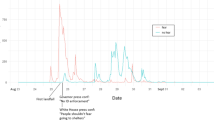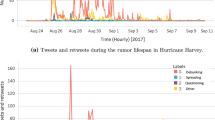Abstract
The rapid spread of rumors occurring on social media is a critical problem that poses a great risk to emergency situation navigation, especially during disasters. Many research questions, such as how misinformed users judge potential rumors or how they respond to them, are crucial issues for crisis communication, but have not been extensively studied. This paper fills this gap by originally documenting and studying Twitter users’ rumor and debunking response behaviors during disasters, such as Hurricane Sandy in 2012 and the Boston Marathon bombings in 2013. To this end, two rumors from each disaster and their related tweets are documented for analysis. Users who were misinformed and involved in the rumor topic by posting tweet(s), could respond to a rumor by: (1) spreading (85.86–91.40%), (2) confirmation-seeking (5.39–9.37%), or (3) doubting (0.71–8.75%). However, if the rumor-spreading users were debunked, they would respond by: (1) deleting rumor tweet(s) (2.94–10.00%), (2) clarifying rumor information with a new tweet (0–19.75%), or (3) neither deleting nor clarifying (78.13–97.06%). We conclude that Twitter users perform poorly in rumor detection and rush to spread rumors. The majority of users who spread rumors do not take further action on their Twitter accounts to fix their rumor-spreading behaviors.










Similar content being viewed by others
References
Abbasi M-A, Liu H (2013) Measuring user credibility in social media. Springer, Berlin, pp 441–448
Alexander DE (2014) Social media in disaster risk reduction and crisis management. Sci Eng Eth 20(3):717–733
Berg BL, Lune H, Lune H (2004) Qualitative research methods for the social sciences, 5th edn. Pearson, Boston
Blake ES, Kimberlain TB, Berg RJ, Cangialosi JP, Beven II, John L (2013a) Tropical cyclone report: Hurricane Sandy (AL182012), Technical report, National Hurricane Center, Miami, FL, USA, 22-29 October 2012
Blake ES, Kimberlain TB, Berg RJ, John PC, Beven II, John L (2013b) Hurricane Sandy: October 22–29, 2012. Tropical Cyclone Rep
Castillo C, Mendoza M, Poblete B (2011) Information credibility on Twitter. In: Proceedings of the 20th International Conference on World Wide Web, WWW ’11, pp 675–684, Hyderabad, India. ACM
Dang A, Smit M, Moh’d A, Minghim R, Milios E (2016) Toward understanding how users respond to rumours in social media. In: 2016 IEEE/ACM International Conference on Advances in Social Networks Analysis and Mining (ASONAM), pp 777–784
Friggeri A, Adamic LA, Eckles D, Cheng J (2014) Rumor cascades. In: Proceedings of the 8th International Conference on Weblogs and Social Media, pp 101–110, Ann Arbor, Michigan
Gayo-Avello EMM, Strohmaier HS, Metaxas PT, Gloor DP, Castillo C, Ma Mendoza, Poblete B (2013) Predicting information credibility in time-sensitive social media. Internet Res 23(5):560–588
Gupta A, Lamba H, Kumaraguru P (2013) $1.00 per RT # bostonmarathon # prayforboston: analyzing faking content on Twitter. In: eCrime Researchers Summit, pp 1–12, San Francisco. IEEE
Harsin J (2006) The rumor bomb: a convergence theory of contemporary mediated American politics. Southern Review: Politics, Communication, Culture, Spring
Hill K (2012) Hurricane Sandy, @comfortablysmug, and the flood of social media misinformation. [EB/OL], http://www.forbes.com/sites/kashmirhill/2012/10/30/hurricane-sandy-and-the-flood-of-social-media-misinformation/#63cd322cd967. Accessed 30 Oct 2012
Hollywood Life Staff (2013) Martin Richard’s death: How I desperately tried to save him. [EB/OL], http://hollywoodlife.com/2013/04/19/martin-richard-death-firefighter-saves-boston-marathon-bombing/. Accessed 19 April 2013
Holt K (2012) How false Sandy news spread on Twitter. [EB/OL], http://www.dailydot.com/news/false-sandy-reports-spread-twitter/ Accessed 30 Oct 2012
Inside Breaking News (2012) Three Sandy rumors that circulated on social media. [EB/OL], http://blog.breakingnews.com/post/34652885735/three-sandy-rumors-that-circulated-on-social. Accessed 30 Oct 2012
Jong W, Dückers MLA (2016) Self-correcting mechanisms and echo-effects in social media: an analysis of the “gunman in the newsroom” crisis. Comput Hum Behav 59:334–341
Kang B, Höllerer T, O’Donovan J (2015) Believe it or not? Analyzing information credibility in microblogs. In: Proceedings of the 2015 IEEE/ACM International Conference on Advances in Social Networks Analysis and Mining 2015, ASONAM ’15, pp 611–616, Paris, ACM
Knopf TA (1975) Rumors, Race, and Riots. Transaction Publishers, Abingdon
Kotz D (2013) Injury toll from Marathon bombs reduced to 264. [EB/OL], http://www.bostonglobe.com/lifestyle/health-wellness/2013/04/23/number-injured-marathon-bombing-revised-downward/NRpaz5mmvGquP7KMA6XsIK/story.html. Accessed 24 April 2013
Leberecht T (2010) Twitter grows up in aftermath of Haiti earthquake. [EB/OL], https://www.cnet.com/news/twitter-grows-up-in-aftermath-of-haiti-earthquake/. Accessed 19 Jan 2010
Levine TR, Park HS, McCornack SA (1999) Accuracy in detecting truths and lies: documenting the “veracity effect”. Commun Monogr 66(2):125–144
Lewandowsky S, Ecker UKH, Seifert CM, Schwarz N, Cook J (2012) Misinformation and its correction continued influence and successful debiasing. Psychol Sci Public Interest 13(3):106–131
Liu X, Nourbakhsh A, Li Q, Fang R, Shah S (2015) Real-time rumor debunking on Twitter. In: Proceedings of the 24th ACM International Conference on Information and Knowledge Management, CIKM ’15, pp 1867–1870, Melbourne, Australia. ACM
Mohaimin SA, Ukkusuri SV, Hugh G (2017) The role of social networks and information sources on hurricane evacuation decision making. Nat Hazards Rev. https://doi.org/10.1061/(ASCE)NH.1527-6996.0000244
Montopoli B (2013) Eight-year-old Martin Richard killed in Boston bombings. [EB/OL], http://www.cbsnews.com/news/eight-year-old-martin-richard-killed-in-boston-bombings/. Accessed 16 April 2013
Morris MR, Counts S, Roseway A, Hoff A, Schwarz J (2012) Tweeting is believing?: understanding microblog credibility perceptions. In: Proceedings of the ACM 2012 Conference on Computer Supported Cooperative Work, CSCW ’12, pp 441–450, Seattle, Washington. ACM
Neuendorf KA (2002) The content analysis guidebook. Sage, Thousand Oaks
Oh O, Agrawal M, Rao HR (2011) Information control and terrorism: tracking the Mumbai terrorist attack through Twitter. Inf Syst Front 13(1):33–43
Oremus W (2012) Dear Twitter, don’t believe everything you hear on a police scanner. [EB/OL], http://www.slate.com/blogs/future_tense/2012/10/30/false_hurricane_sandy_rumors_police_scanner_fools_twitter_into_spreading.html. Accessed 30 Oct 2012
Ozturk P, Li H, Sakamoto Y (2015) Combating rumor spread on social media: the effectiveness of refutation and warning. In: 2015 48th Hawaii International Conference on System Sciences (HICSS), pp 2406–2414, Hawaii, USA
Patton MQ (1990) Qualitative evaluation and research methods, 2nd edn. SAGE, Newbury Park
Richards J, Lewis P (2011) How Twitter was used to spread—and knock down—rumours during the riots. [EB/OL], https://www.theguardian.com/uk/2011/dec/07/how-twitter-spread-rumours-riots. Accessed 07 Dec 2011
Rosnow RL (1991) Inside rumor: a personal journey. Am Psychol 46(5):484
Rosnow RL, Fine GA (1976) Rumor and gossip: the social psychology of hearsay. Elsevier, Amsterdam
Rubin VL (2017) Deception detection and rumor debunking for social media. In: Sloan L, Quan-Haase A (eds) The SAGE handbook of social media research methods. Sage, Beverly Hills
Sager J (2013) 10 Boston Marathon bombing rumors that need to be stopped immediately. [EB/OL], http://thestir.cafemom.com/crime/154242/10_boston_marathon_bombing_rumors. Accessed 17 April 2013
Shibutani T (1969) Improvised news: a sociological study of rumor. Soc Res 36(1)
Starbird K, Maddock J, Orand M, Achterman P, Mason RM (2014) Rumors, false flags, and digital vigilantes: misinformation on Twitter after the 2013 Boston Marathon bombing. In: iConference 2014 Proceedings, pp 654–662, Berlin, Germany. iSchools
Tripathy RM, Bagchi A, Mehta S (2013) Towards combating rumors in social networks: models and metrics. Intell Data Anal 17(1):149–175
Tripathy RM, Bagchi A, Mehta S (2010) A study of rumor control strategies on social networks. In: Proceedings of the 19th ACM International Conference on Information and Knowledge Management, CIKM ’10, pp 1817–1820, Toronto, ON, Canada. ACM
Twitter Developer Documentation. REST APIs. [EB/OL]. https://dev.twitter.com/rest/public
Wang B, Zhuang J (2017) Crisis information distribution on Twitter: a content analysis of tweets during hurricane sandy. Nat Hazards 89(1):161–181
Wemple E (2012) Hurricane Sandy: NYSE not flooded! [EB/OL], https://www.washingtonpost.com/blogs/erik-wemple/post/hurricane-sandy-nyse-not-flooded/2012/10/30/37532512-223d-11e2-ac85-e669876c6a24_blog.html?utm_term=.c6ec07080562. Accessed 30 OCT 2012
Zhao L, Yin J, Song Y (2016) An exploration of rumor combating behavior on social media in the context of social crises. Comput Hum Behav 58:25–36
Zubiaga A, Liakata M, Procter R, Hoi GWS, Tolmie P (2016) Analysing how people orient to and spread rumours in social media by looking at conversational threads. Plos One 11(3):e0150989
Acknowledgements
This research was partially supported by the United States National Science Foundation (NSF) under award numbers 1730503, 1760586, 1762807. This research was also partially supported by China Scholarship Council (CSC) to support Bairong Wang. However, any opinions, findings, and conclusions or recommendations in this document are those of the authors and do not necessarily reflect views of the NSF, or CSC. We also thank two referees for providing constructive comments.
Author information
Authors and Affiliations
Corresponding author
Rights and permissions
About this article
Cite this article
Wang, B., Zhuang, J. Rumor response, debunking response, and decision makings of misinformed Twitter users during disasters. Nat Hazards 93, 1145–1162 (2018). https://doi.org/10.1007/s11069-018-3344-6
Received:
Accepted:
Published:
Issue Date:
DOI: https://doi.org/10.1007/s11069-018-3344-6




